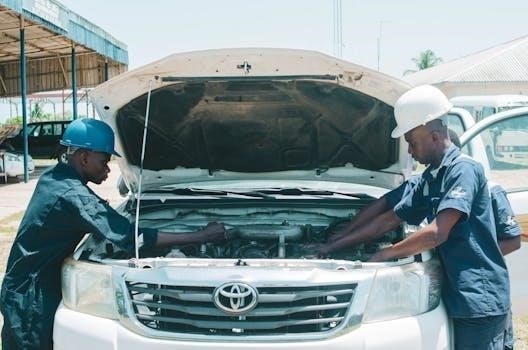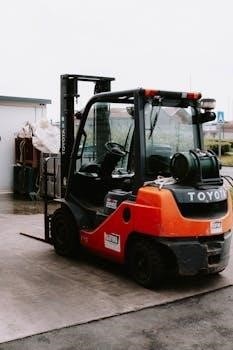
This guide provides essential information for maintaining your Toyota Sienna. Understanding common issues‚ like sliding door malfunctions and oxygen sensor problems‚ is crucial. Regular checks for oil leaks‚ dashboard cracks‚ and electrical system health will help ensure your Sienna’s longevity and reliability. This guide helps you keep your vehicle in optimal condition.
Maintaining your Toyota Sienna is crucial for ensuring its longevity‚ reliability‚ and overall performance. This guide provides a comprehensive overview of essential maintenance procedures‚ common problems‚ and proactive steps to keep your minivan in top condition. Regular maintenance not only extends the life of your vehicle but also helps prevent costly repairs down the road. Understanding the specific needs of your Sienna model‚ including potential issues related to its generation‚ is important for effective maintenance. From routine oil changes to checking the electrical system‚ this guide covers various aspects of Sienna care. By following the recommended maintenance schedule and addressing potential problems promptly‚ you can maximize your Sienna’s performance‚ safety‚ and value. This introduction sets the foundation for a journey into the detailed maintenance practices required to keep your Toyota Sienna running smoothly for years to come. Remember‚ a well-maintained vehicle is a safer‚ more reliable‚ and enjoyable one.

Regular Oil Change Procedures
Regular oil changes are a cornerstone of Toyota Sienna maintenance‚ crucial for engine health and optimal performance. Typically‚ oil changes are recommended every 5‚000 to 7‚500 miles‚ but consulting your owner’s manual for specific guidelines is essential. The procedure involves draining the old oil‚ replacing the oil filter‚ and refilling with the recommended type and amount of new oil. Using the correct oil viscosity‚ as specified by Toyota‚ ensures proper lubrication and reduces engine wear. Before starting‚ make sure the engine is warm‚ but not hot‚ to allow the oil to flow freely. Ensure you have the necessary tools‚ including a wrench for the drain plug‚ an oil filter wrench‚ a funnel‚ and a container for the old oil. Proper disposal of used oil and filters is vital for environmental responsibility. Regular oil changes help prevent sludge buildup‚ maintain engine cleanliness‚ and contribute to the overall longevity of your Sienna’s engine. Skipping oil changes can lead to serious engine damage and costly repairs‚ highlighting the importance of this routine maintenance task.
Tire Maintenance and Run-Flat Issues
Maintaining proper tire health is crucial for your Toyota Sienna’s safety and performance. Regular tire pressure checks‚ at least monthly‚ are essential‚ ensuring they match the manufacturer’s recommended PSI‚ typically found on a sticker inside the driver’s doorjamb. Rotate your tires every 5‚000 to 7‚500 miles to promote even wear and extend their lifespan. Inspect tires regularly for signs of damage‚ such as cuts‚ bulges‚ or uneven wear patterns. A significant concern for some Sienna owners is the use of run-flat tires‚ which‚ while offering convenience in case of a puncture‚ can be problematic. These tires often provide a harsher ride and are more expensive to replace. Some owners have expressed frustration with their limited ability to travel long distances at high speeds on a flat tire. The absence of a spare tire in some models makes run-flat tire maintenance all the more important. Consider the pros and cons of run-flats when deciding on tire replacements‚ and always prioritize safety and proper tire inflation for optimal handling and fuel efficiency.

Brake System Inspection and Service
Regular brake system inspections are paramount for ensuring the safety and reliability of your Toyota Sienna. It is advisable to check your brakes at least every six months or during routine maintenance visits. Pay close attention to any unusual noises‚ such as squealing‚ grinding‚ or clicking‚ which may indicate worn brake pads or rotors. Brake pads should be inspected for wear and replaced when they reach their minimum thickness. Check the brake rotors for signs of damage or warping‚ and ensure that the brake fluid is at the proper level and free from contaminants. If you notice a spongy brake pedal or increased stopping distance‚ seek immediate professional service. The brake lines should also be inspected for leaks or damage. Properly maintained brakes are vital for preventing accidents and ensuring responsive stopping power. Neglecting brake maintenance can lead to costly repairs and compromised safety. Always adhere to manufacturer recommendations for brake service intervals.
Coolant System Maintenance and Common Leaks
Maintaining your Toyota Sienna’s coolant system is crucial for preventing overheating and engine damage. Regularly check the coolant level in the reservoir and top off with the correct type of coolant as needed. Inspect the radiator‚ hoses‚ and water pump for any signs of leaks or corrosion. Common leak sources in the Sienna include the water pump and radiator. The 3.5-liter V6 engine‚ used in the 2nd and 3rd generation Siennas‚ is particularly prone to these issues. Replace worn or damaged hoses promptly to avoid coolant loss. Coolant leaks can lead to overheating‚ which can cause serious engine damage‚ including warped cylinder heads. Periodically flush and replace the coolant according to the manufacturer’s recommended intervals. This practice ensures the coolant retains its protective properties‚ preventing corrosion and maintaining optimal engine temperature. If you notice a sweet smell or coolant puddles under your vehicle‚ seek immediate professional attention to diagnose and repair the leaks.
Transmission Maintenance and Potential Problems
Proper transmission maintenance is vital for the longevity and smooth operation of your Toyota Sienna. Regularly check the transmission fluid level and condition‚ ensuring it’s clean and at the correct level. A dark or burnt-smelling fluid indicates the need for a fluid change. Follow the manufacturer’s recommended service intervals for transmission fluid replacement‚ as this can prevent costly repairs. Some older Sienna models have experienced transmission issues‚ including sudden loss of power. These problems can be exacerbated by issues with the oil cooler hose‚ which may cause further engine damage. If you notice symptoms like slipping gears‚ rough shifting‚ or unusual noises‚ seek professional diagnosis and repair immediately. Ignoring these issues can lead to complete transmission failure. Regular maintenance can help prevent such problems and keep your Sienna running smoothly. Always use the correct type of transmission fluid specified in your owner’s manual to prevent damage and ensure optimal performance.
Sliding Door Maintenance and Repair
Sliding door issues are a common concern for Toyota Sienna owners‚ often manifesting as partial or total failure of the automatic mechanism. Regular maintenance can help prevent these problems. If your doors open manually but the buttons are unresponsive‚ it indicates a potential issue with the electrical or cable system. The cable system often wears out‚ damaging the latch motor behind the door mechanism. Sometimes‚ a circuit overload can upset the fuse‚ preventing normal door operations. Pay attention to any unusual noises or sluggish movement. If one door malfunctions‚ address it promptly‚ as the problem may spread. Replacing worn cables or a faulty latch motor can restore optimal door function. Avoid prolonged manual operation‚ as it can worsen underlying problems. If repairs are required‚ ensure they are done by a qualified technician to prevent further damage. Regularly check and lubricate the door tracks and hinges to ensure smooth movement. By doing so‚ you can help keep your Sienna’s sliding doors in good working order.
Oxygen Sensor Issues and Replacement
The oxygen sensor is a critical component in your Toyota Sienna‚ measuring the oxygen-to-exhaust gas ratio. Problems with this sensor are common across many model years‚ impacting engine performance and emissions. A failing sensor can disrupt combustion and acceleration‚ and affect the air-fuel mixture regulation. This can lead to poor fuel economy and a check engine light. Contamination from oil-rich mixtures or coolant burning can damage the sensor. Age‚ corrosion‚ and electrical issues can also cause it to fail; A malfunctioning oxygen sensor can affect the catalytic converter‚ leading to increased pollution. If you notice reduced engine response or poor fuel consumption‚ a faulty oxygen sensor might be the cause. Prompt replacement is essential to maintain optimal engine performance‚ reduce emissions‚ and prevent costly damage to other components. When replacing the oxygen sensor‚ ensure you use a high-quality part and follow proper installation procedures. If you are not comfortable doing the replacement yourself‚ seek professional help. Regular inspection of the emission system is important.
Addressing Oil Leaks and Hose Problems
Oil leaks are a significant concern for Toyota Sienna owners‚ often stemming from defective oil lines. These lines‚ prone to rupturing‚ can cause oil loss while driving‚ sometimes without triggering warning lights. This is dangerous because a lack of warning can lead to severe engine damage. A defect in the engine oil hoses is the primary cause of this problem‚ although rodents can also cause damage to the oil lines. If you suspect a leak‚ immediate replacement of the hose is necessary. Clean up any spilled oil promptly. Regular visual inspections of oil lines are crucial‚ especially if warning lights are unreliable. To prevent rodent damage‚ park your Sienna in a garage and avoid leaving food or other attractants in the vehicle. Toyota provided an improved line‚ but problems persisted. This maintenance point helps ensure the vehicle remains safe and reliable.
Dashboard Cracks and Prevention

Dashboard cracks are a prevalent issue‚ especially in older Toyota Sienna models‚ often appearing before the vehicle reaches 100‚000 miles. This problem primarily affects models manufactured before 2010‚ with 2004‚ 2005‚ and 2006 models being particularly susceptible. Drivers have reported that dashboards appear to melt or crack‚ which could affect airbag deployment and even cause radio malfunctions. These cracks are mainly due to prolonged exposure to the sun’s ultraviolet rays. To prevent this‚ parking in garages or using car covers regularly is recommended. Windshield shades can also protect the dashboard from UV rays. Since dryness can contribute to cracks‚ using tested moisturizers on the dashboard can help. Avoid using damp rags for cleaning. While Toyota has seemingly addressed this issue in newer models‚ owners of older Siennas should take preventative measures to maintain their dashboards. Some owners replaced or repaired their dashboards.

Electrical System Checks and Troubleshooting
Maintaining the electrical system in your Toyota Sienna is crucial for ensuring all components function correctly. Regularly check the battery terminals for corrosion and ensure they are securely connected. Inspect the wiring harness for any signs of damage‚ such as fraying or exposure‚ which could lead to shorts or malfunctions. Problems with the electrical system can manifest in various ways‚ including issues with power windows‚ door locks‚ and the infotainment system. A common issue is circuit overload‚ which can upset the fuse and prevent normal door operations. If you experience unusual electrical behavior‚ check the fuses and replace any that are blown. Additionally‚ be aware that sensor issues‚ like oxygen sensor problems‚ can sometimes trigger electrical system warnings. Addressing electrical issues promptly can prevent more significant problems and ensure your Sienna’s safety and reliability. Always consult a qualified technician for complex electrical repairs.
Recalls and Common Problems by Model Year
Understanding the specific recalls and common issues associated with your Toyota Sienna’s model year is vital for proactive maintenance. Some Sienna models have been subject to recalls for issues like Takata airbags‚ which require immediate attention. Older models‚ particularly those from 1998 to 2010‚ are prone to dashboard cracks due to sun exposure‚ with the 2004‚ 2005‚ and 2006 models being particularly affected. The 2007 Sienna has been known for transmission and oil cooler hose problems‚ leading to potential power loss and engine damage. Additionally‚ certain model years have experienced issues with oxygen sensors‚ sliding doors‚ and oil leaks. It’s crucial to stay informed about any recalls issued by Toyota and to be aware of the common problems reported for your specific model year. This knowledge can help you address issues early‚ preventing more significant damage and ensuring your Sienna’s safety and performance. Always check official Toyota resources for the latest recall information and consult with a mechanic experienced with Sienna models.